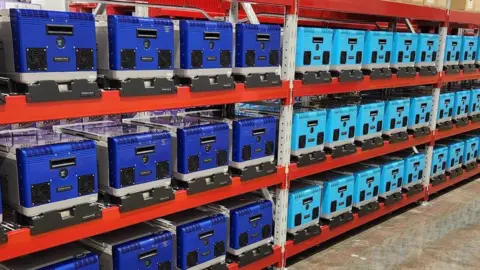Expertise Reporter
 Getty Photographs
Getty PhotographsSneha Sachar, who spent half her life in Delhi and now lives in California, is used to warmth. However her hometown feels a lot hotter now than when she was rising up.
Even commuting by automobile is so uncomfortable in sure months, says Ms Sachar, who works for the Clear Cooling Collaborative, a philanthropic initiative centered on improved cooling.
Rising temperatures are even worse for outdoor workers. “That is actually impacting the flexibility of individuals to proceed to earn their livelihoods,” Ms Sachar says.
She says that there are a selection of low-tech methods to maintain buildings cool, comparable to designing for air movement.
For out of doors employees, even a 20-minute break from the warmth and humidity, comparable to in well-designed cooling stations, could make a distinction.
However past this, lively cooling will turn into more and more crucial as temperatures proceed to rise as a consequence of local weather change.
Morgan Stanley is predicting that the annual progress price of the cooling market, already value $235bn (£180bn) a 12 months, could more than double by 2030.
 Getty Photographs
Getty PhotographsBut current cooling units have severe drawbacks. One difficulty the refrigerant – the fluid that transitions backwards and forwards from liquid to fuel, in a course of that transfers warmth.
It’s normal for them to leak from normal techniques, harming each effectivity and probably well being.
The refrigerants sometimes utilized in cooling right this moment are hydrofluorocarbons (HFCs), a gaggle of artificial gases with excessive international warming potential. HFCs are rather more potent than carbon dioxide.
So one possibility is to switch the refrigerants with extra climate-friendly variations. However the candidates with the decrease international warming potential, even have issues.
For example, propane is extremely flammable. Ammonia is poisonous. Carbon dioxide works at excessive pressures, requiring specialised gear.
However as many locations section down HFCs, various refrigerants will stay vital.
Ms Sachar says that we nonetheless want refrigerants as a result of for house cooling, “A/Cs as we all know them right this moment will proceed to be the answer, no less than for the following decade or so”.
 Tati van Thiel Images
Tati van Thiel ImagesIn the long term, some scientists are trying towards cooling units that do not want liquid refrigerants in any respect.
Lindsay Rasmussen, who manages constructing and land-use initiatives on the power non-profit RMI, calls these “revolutionary applied sciences”.
A serious set of revolutionary cooling tech is solid-state cooling. This makes use of strong supplies and a few form of extra power to induce temperature modifications. That further power could possibly be stress, voltage, magnets or mechanical stress.
Ms Rasmussen says that solid-state units can go additional than incremental enhancements as a result of “not solely do they remove these super-polluting refrigerants, however they’ll additionally provide improved effectivity to the techniques”.
RMI has recognized between 10 and 20 start-ups engaged on early variations of solid-state cooling units.
A type of startups is the German firm Magnotherm, which makes use of magnets. Sure supplies change temperature when uncovered to magnetic fields.
“With our know-how, it is inherently protected as a result of it is not poisonous, it is a steel, and we function at very low pressures,” in line with Timur Sirman, the CEO and cofounder of Magnotherm.
The thought of magnetocaloric cooling has been round for years, however commercialising it’s comparatively new. Magnotherm has constructed about 40 beverage coolers, and about 5 fridges, in what’s to this point a guide and in-house course of.
The everlasting magnets are the most costly a part of the know-how, Mr Sirman experiences. “However it by no means breaks, so we are able to at all times reuse this fairly cost-intensive element.”
The corporate is in search of out various sources of magnetic fields, in addition to optimising supplies, as they purpose to dramatically improve the cooling capability of their units.
Mr Sirman believes that in case you account for the effectivity and well being problems with refrigerants, like leakages, Magnotherm merchandise can compete on worth. “We’re not concentrating on clients who’re solely taking a look at preliminary price.”
He acknowledges that for now the corporate’s beverage coolers are fairly expensive. Their clients are typically early adopters of recent applied sciences.
 Phonic
PhonicOne other know-how beneath growth is thermoelectric cooling.
This includes shifting warmth between two sides of a tool. With the appliance {of electrical} power, warmth is transferred within the path of the present.
A notable thermoelectric start-up is Phononic, which relies within the US and has a further manufacturing facility in Thailand.
Thousands and thousands of Phononic cooling units at the moment are in use, together with in information centres, supermarkets and different buildings.
Their cooling units are inbuilt an analogous strategy to laptop chips, utilizing semiconducting supplies to switch the warmth.
“Our chips are actually skinny, actually small, however they get actually chilly. They eat a small quantity of electrical energy in producing that coldness, however they pack one hell of a punch,” says Tony Atti, the CEO of Phononic.
He says that, to work at their greatest, conventional fridges should be run on a regular basis.
However thermoelectric units will be simply switched on off. This helps to cut back the prices, power use and house necessities.
“We prefer to current the coolness on demand the place you want it,” says Mr Atti.
One other benefit is that thermoelectric cooling can function silently. “That is as a result of there’s zero shifting elements,” Ms Rasmussen explains. “The warmth is happening due to the response within the materials degree.”
In distinction, normal vapour compression techniques comprise pumps, condensers and expanders for refrigerant, which all generate a lot of the noise.
A unique kind of solid-state cooling is elastocaloric cooling. This achieves temperature modifications by means of mechanical stress to elastocaloric supplies, which might calm down or warmth up with the appliance of stress.
Researchers in 4 European international locations are collaborating on SMACool, an elastocaloric air conditioner that makes use of steel tubes constituted of particular metallic alloys.
In the meanwhile, elastocaloric prototypes have a lot decrease cooling capability than industrial air-con. And the utmost potential effectivity of SMACool remains to be decrease than that of standard air-con, though the purpose is to beat the energy efficiency of A/C.
Nonetheless, progress is constant. A team led by Hong Kong researchers not too long ago created an A/C various that achieved a cooling energy of 1,284W—the primary time an elastocaloric machine surpassed the 1,000W mark. One innovation was utilizing graphene nanofluid reasonably than distilled water to switch the warmth.
Total, Ms Rasmussen says, solid-state units are typically not but as highly effective as standard vapour-compression air-con. However she expects efficiency enhancements over time.
She additionally expects enhancements in affordability. To this point solid-state cooling has primarily been deployed in rich international locations.
A key query, Ms Rasmussen says, is “Can these applied sciences scale as much as the place they could possibly be reasonably priced for individuals who want it probably the most and the place the best demand for cooling is coming from?”



